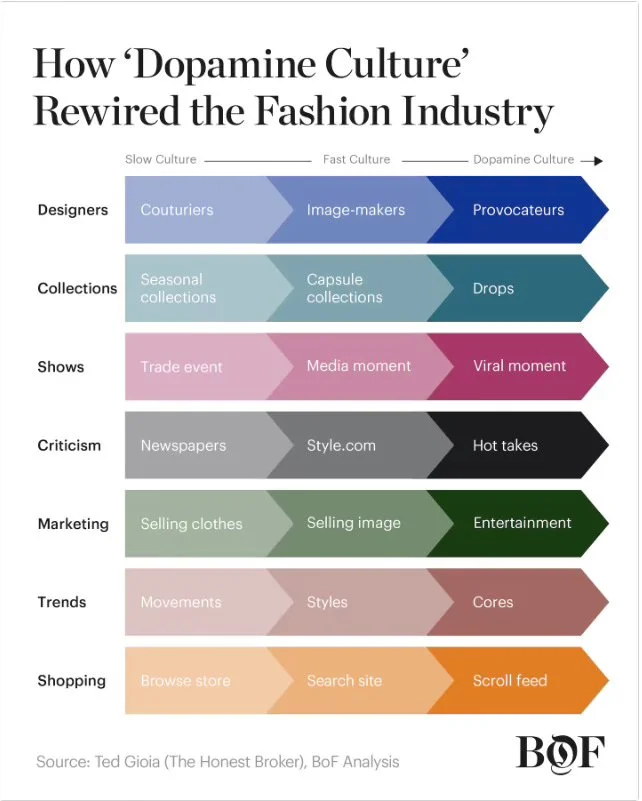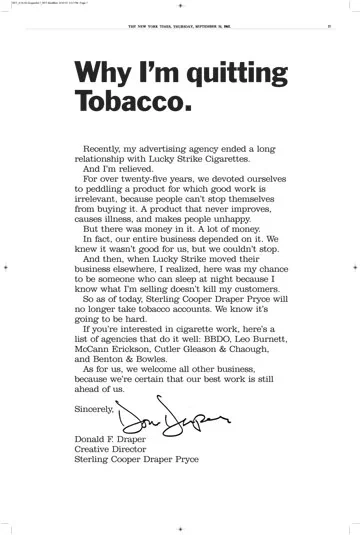Beyond the Bait
From the BoF article here
Ted Gioia identified the problem of dopamine culture and outlined how consumers can break free.
But as someone working on change management from within organisations, I want to focus on the big question:How do we dismantle a system we helped build?
With that in mind, I’m going to reframe Dopamine Culture as Bait Culture. Dopamine Cuture sounds nice, like a good thing: who doesn’t want to create a culture of helping people feel good? But when looking at it all a little more closely, it seems a bit more like Bait. A systematic approach to dangling dopamine like a carrot on a stick, creating addiction rather than joy.
And not just the addiction of the end-user, but also the addiction of brand leaders seeking dopamine from the next viral hit or sold-out drop.
Bait Culture it is.
Does this serve the needs of the people in the system?
In a word: No.
And yet, we still talk about building "fans" and "fandom" as the ultimate brand goal. We love customers who obsessively collect every product drop or who queue for hours for limited releases. But thinking beyond the diplomatic/corpcore jargon, and aren't we just describing some soft, PG-13 version of addicts?
What's the real-world difference between a "superfan" who compulsively buys every collab and someone with a legit shopping addiction?
By engineering Superfans - as great as it makes us sound in those back-to-back meetings - are we really serving customer-first needs? And what about our own brand needs - is bankrupting the audience really the path to brand love?
How did we get here?
We’re all part of the system. Everything is connected.
Personally, I've absolutely sat in those performance meetings where we reviewed every piece of content through the lens of "make number go up."
The problem isn't individual marketers and tech bros being inherently evil and simple little scapegoats. It's that when the Christmas bonus (at a time of cost of living crisis) depends on metrics like "time spent" or "daily return visits," underpaid and overworked employees are incentivised to create addictive experiences - intentionally or not. The creative-adjacent marketing manager, the UX designer and the social strategist have bills to pay.
And dopamine - when it occurs naturally - is great, wonderful, lovely stuff. Good times! The problem exists when we manufacture the surface-level, sugar-high version: extracting all those engagement behaviours and giving very little in return, in our everlasting quest for more growth and more in general. Bad times.
So if dopamine isn’t a bad thing, but designing specifically with dopamine-first in mind is…how might we design experiences that are fun without becoming addictive?What kind of bonus or incentives can we give the UX designer, the marketing manager and the social strategists?
And how can we get back to serving the needs of the people in the system? Since everything is connected and we had a hand in getting here, we are part of building the better alternative too.
Cut it out
“Reclaiming the narrative and survival mode” plot-line aside, I’m reminded of ‘The Letter’ in Mad Men, more specifically:
“…we devoted ourselves to peddling a product for which good work is irrelevant, because people can’t stop themselves from buying it. A product that never improves, causes illness and makes people unhappy.”
Today, it’s less about Tobacco as the product and more about Bait as the system, but the concept remains the same, right? A system that people can’t stop themselves from using, a system that never improves, causes illness and makes people unhappy.
Back in the modern-day, real-world and let’s consider LUSH: who famously left Instagram, Facebook, TikTok and Snapchat for this exact reason and all these years later see the positives:
“…we have done a good job of making sure customers can access us by building other strong communication tools that are not social media, like our newsletters, app and in-store activities. Leaving [social media] has had a positive impact on the business in the sense that we now take more thought into how we approach our communication with our customers.”
Lush Chief Digital Officer, Jack Constantine
Contrary to popular belief re: tech giants and other bad actors, nobody is too big too fail (see also: all empires throughout history.) In fact, it’s exactly this mentality that maintains the status quo.
Because the system is already beginning to change. Users are leaving platforms, engagement rates are shifting, and brands are questioning ROI on dopamine-driven strategies. The downstream effect of eliminating boredom (aka the essential spark for creativity) is paradoxically creating the most boring digital landscape in living history.
And so, the market correction pendulum-swings into action. The question for brand leaders is pretty simple: will you be an early adopter and lead the shift away from addiction-based engagement, or a laggard clinging to a failing model until it completely collapses?
How to create fun experiences without engineering addiction
The obvious, top of the to-do list is to review all those internal KPIs, metrics and target-based performance incentives to determine what kind of an audience we are really creating. A good example.
Stop Copying the Unhinged and the Viral
Is Hailey Beiber your CEO? A green owl your mascot? No and no? Then no, Rhode and Duolingo’s content strategies cannot be ctrl+v ctrl+c duped with equivalent virality. Get clear on what your brand can uniquely offer your audience to help them achieve their goals, and let the team take risks in delivering on that. Sure, “unhinged content” sounds great in theory, but what’s the downstream impact on the very real people experiencing your always-on bait day-in, day-out?
Go Deep
Step away from the ChatGPT research. How often do you talk to your most valued customers directly? Do you know - honestly - what they want and why? Get to know their psychological needs not as a means to manipulate, but to create meaningful, core-memory-building experiences that reward with deep dopamine:
Control: Create customisation opportunities or educational content that helps them make better decisions.
Purpose: Design volunteering moments and community experiences, or storytelling opportunities that help them connect with something larger.
Play: Build interactive experiences that have just the right amount of friction for flow, and reward with something a bit more meaningful than ‘gamification’ addictive points and badges.
Start Co-Creating
Tied to the above but in a nutshell: shift from the mindset of the top-down broadcast to collaboration. Many brands avoid this because it sounds so messy from the outside but when I worked for a Canadian menswear startup, we regularly chatted on the phone (yes, really!) with our regular customers to understand what we could uniquely offer them. We built real first-name basis relationships and developed the brand experience with them. Again: not as a means to create “Superfans” but to generate less waste and more value i.e. the things our customers actually wanted.
We created this system, which means we can redesign it.
The shift from Bait Culture to better culture won't happen overnight. But the early signals are here and it begins with recognising that we're all interconnected parts of the same system. When we change how we measure success and reward our teams, we change the customer-first outputs and the experience.
Yes, it requires some courage. Being the first ones to make a move, and potentially taking short-term hits while reorienting for the long-term. But let’s think about the alternative: continuing to fuel a system that's making everyone miserable. Why bother with that?
In the end, which brand would you rather create, work for and recommend - the toxic one or the genuinely fun and helpful one?



